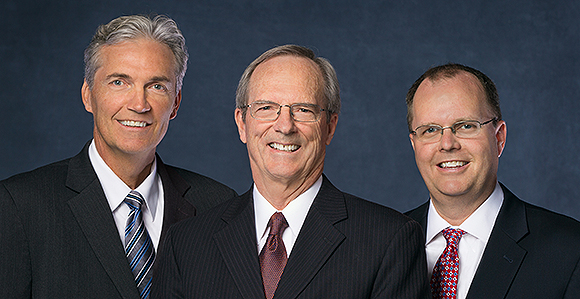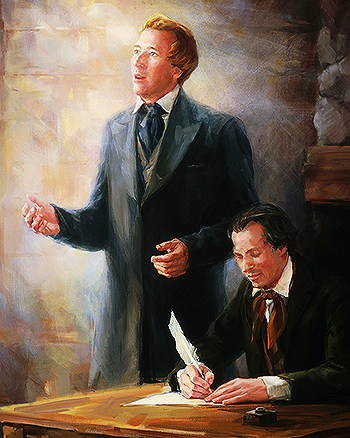Study of Doctrine and Covenants in 2017 Can Increase Faith, Sunday School Leaders Say
Contributed By R. Scott Lloyd, Church News staff writer

Sunday School General Presidency: Brother Tad R. Calliser, President, center; Brother Devin G. Durrant, First Counselor, left; and Brother Brian K. Ashton, Second Counselor.
Article Highlights
- The current dispensation provides important truths not available previously.
- Joseph Smith exemplified how to receive revelation.
- The Doctrine and Covenants shows us how to learn, the Lord’s way.
“The purpose of Sunday School is to help us understand the doctrine and live it so that we become more like Jesus Christ.” —Brother Brian K. Ashton of the Sunday School General Presidency
Related Links
As Church members embark in the new year on a study of the Doctrine and Covenants and Church history, it is good to bear in mind that in this dispensation of the fulness of times, additional truths are available that were not had anciently, the General President of the Sunday School said.
Brother Tad R. Callister and his counselors in the Sunday School General Presidency, Brother Devin G. Durrant and Brother Brian K. Ashton, discussed the 2017 Gospel Doctrine course of study during an interview with the Church News.
“We have not only all of the truth from all other dispensations, but we have additional truth from our dispensation,” Brother Callister said. “The Doctrine and Covenants gives us some of those truths that allow us to call this the dispensation of the fulness of times. So I think one of the great blessings is we can learn from the Doctrine and Covenants the fulness of the gospel the Lord wants us to have at this time.”
Brother Durrant said, “Our purpose from year to year is to bring about conversion and bring people closer to Christ. One of the ways that happens is that we ask questions and receive answers. The Doctrine and Covenants answers a lot of the questions that the Prophet Joseph and those who were close to him had, and through that process, we got to what Brother Callister outlined, the restoration of the fulness.”

Painting by Judith A. Mehr portrays Joseph Smith Jr. receiving a revelation at the organization of the Church.
Brother Ashton said that an interesting aspect of Church history is that it shows that miracles occur today as they did in the past. “Those miracles can happen in our own lives,” he affirmed. “God is still a God of miracles.”
Brother Callister noted that the Prophet Joseph Smith can be regarded as a prototype for the manner in which one receives revelation.
“He was the master asker,” he said. “He just kept asking questions. Because he was the master asker, he was the master receiver of revelation. That’s why we’re blessed to have the Doctrine and Covenants. He asked sincerely, and the Lord wanted to respond.”
Brother Callister said that is the reason he likes Doctrine and Covenants 42:61, which reads:
“If thou shalt ask, thou shalt receive revelation upon revelation, knowledge upon knowledge, that thou mayest know the mysteries and peaceable things—that which bringeth joy, that which bringeth life eternal.”
Some helpful study resources
Brother Durrant highlighted some new resources available to Church members in Sunday School classes to enhance their study of the Doctrine and Covenants and Church history.
Gospel Doctrine lessons on ChurchofJesusChrist.org will have links to Revelations in Context, as well as links to pages about Church historic sites, Gospel Topics, updated videos, and other resources, Brother Durrant noted.
Revelations in Context, available both in print and online, provides insightful background on practically every section of the Doctrine and Covenants, including accounts of individuals involved in important revelations.
Historic sites are online exhibits that take visitors to the sites of the Restoration of the gospel and provide history of places from Palmyra, New York, to Jackson County, Missouri, and beyond.
Gospel Topics essays are in-depth articles approved by Church leaders that provide accurate information gathered from reliable sources on a variety of subjects.
Brother Ashton noted, “The purpose of Sunday School is to help us understand the doctrine and live it so that we become more like Jesus Christ, and these resources shouldn’t be an end in themselves. They help us to understand the doctrine more fully so that we can live it more fully. I think it’s important to understand that.”
Three essential doctrines
The members of the presidency are united in highlighting three essential doctrines taught in the Doctrine and Covenants:
- The plan of salvation
- The Atonement of Jesus Christ
- The doctrine of Christ
Brother Callister explained their interrelationship: “The plan of salvation was given to us from the premortal existence to help us become like God. The Atonement of Jesus Christ made it possible to achieve that plan, and the doctrine of Christ is what we must do to avail ourselves of the Atonement.”
Brother Ashton added, “The plan of salvation defines the blessings the Father is willing to give us.”
Brother Durrant said, “Within the doctrine of Christ is faith in the Lord Jesus Christ. That’s the outcome that we hope for as we study the Doctrine and Covenants: an increase in our faith in Jesus Christ.”
He said that the people who are highlighted in the Doctrine and Covenants “are closer to us, simply by time” than those whose lives are recounted in other volumes of scripture. “That might make it easier to relate to them. As we come to understand Joseph Smith better, to learn more about him, that brings us closer to Christ and to our Heavenly Father as well.”
Brother Ashton said, “The Doctrine and Covenants defines the way in which we should be learning, the Lord’s way.”
He cited Doctrine and Covenants 88:118–26, pointing out that “as all have not faith,” the process involves seeking diligently and teaching one another words of wisdom “out of the best books” and doing it by study as well as by faith.
The section goes on to outline the spiritual process, including clothing oneself with the bond of charity, Brother Ashton pointed out.
“Those who are struggling with questions—and we all have some questions—have the opportunity to learn that process this year in studying the Doctrine and Covenants,” he said.
Brother Callister added, “The purpose is to learn the doctrine and live it so we can become like Christ. That brings more light into our lives. As it brings more light into our lives, we of necessity have less darkness. As we increase our faith, we decrease our doubt, and that’s why it’s important to learn about the doctrine.”
Other helpful resources
The following additional resources are helpful for teaching and studying the Doctrine and Covenants:
-
Prophets of the Restoration. Online exhibits and short videos about the key events and ministry of each of the presidents of the Church.
-
Foundations of Faith. A digital exhibit of 25 important records from the Church’s history.
-
Church History Study Guide. Online guide that provides additional resources for each lesson in the Gospel Doctrine Teacher Manual.
-
The Heavens Are Opened. An interactive, online guide to objects inside of the Church History Museum that played notable roles in the restoration of the Church.
-
Joseph Smith's Accounts of the First Vision. Joseph Smith’s four accounts of the First Vision. Read a summary of these four accounts.
-
Church Historian's Press. Provides news and links to resources.
-
Joseph Smith Papers. Original documents transcribed and annotated that provide in-depth insight on every major aspect of the restoration and founding of the Church.
-
The First Fifty Years of Relief Society. Original, annotated documents conveying the challenges, contributions, devotion, and teachings of early Latter-day Saint women. Available online and in print.
-
Our Heritage: A Brief History of The Church of Jesus Christ of Latter-day Saints. Gives background information on Church history. Many of the lessons in the course include a reading assignment from this book. The book is available online, in print, and in the Gospel Library mobile app.
